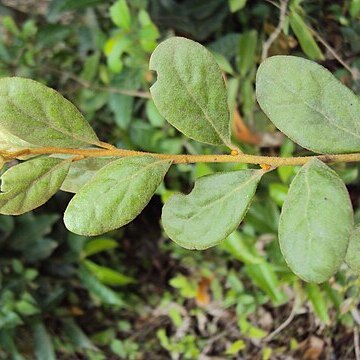Young parts with a sparse to dense grey to dark brown or rarely paler indumentum of short stellate hairs, soon becoming sparse on adult stems and leaves. Leaves opposite; lamina narrowly ovate to obovate, 3-7(-9) by 1.5-3.5(-4.5) cm, thin, cuneate to truncate at the base to a petiole 3-10 mm long, acute, obtuse or rounded at the apex; venation obscure except for the midrib and a few major laterals visible on both sides. Inflorescencess several at the nodes, a 2-to 6-flowered raceme; axis 1-6 mm long; pedicels 1-5 mm long; bract narrow, erect, 1-3 mm long. Corolla in mature bud 8-16 mm long, slender, weakly clavate and acute at the apex; tube 6-12 mm long, split to the middle or lower. Anther 0.7-1.5 mm long, about two thirds as long as the free part of the filament. Fruit 8-10 mm long including a stipe 4-8 mm long, rounded at the apex.
A shrub which grows by feeding on other plants. The young parts are hairy. The leaves are stalked. They are opposite and 1.5-3 cm long by 0.5-1.5 wide. They are oval and leathery. They have a rusty coating on both surfaces when young. They are smooth at maturity. The flowers are red. They occur in dense arrangements on the axils of leaves. The fruit is pear shaped.

